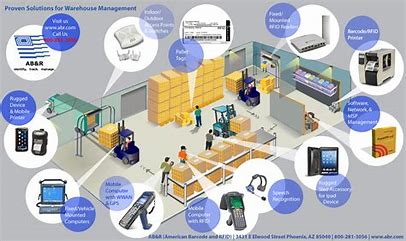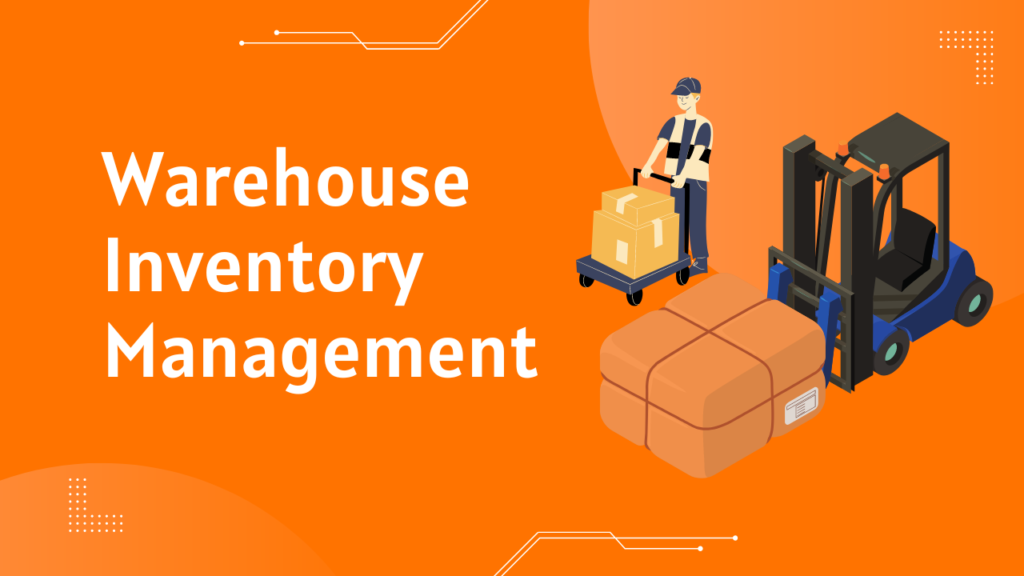Managing Inventory in a warehouse can be a challenging task, especially with pressure from buyers and store locations. It is essential to keep up with inventory demands while monitoring the inventory process, worker needs, and customer or buyer requirements. Implementing a proper warehouse inventory management practice is crucial for businesses to fulfill all these requirements.
In this blog post, we will discuss some of the best ideas to make inventory management run smoothly in your warehouse, even if your business is small this optimization will help you to grow rapidly.
Why optimize your warehouse inventory management?

See what benefits you will get by optimizing your warehouse inventory
- including lower working capital,
- reduced logistics costs,
- decreased obsolescence
- increased revenue from fewer lost sales orders.
By improving the flow of products in and out of your warehouse, you can save money and handle more efficiently. Additionally, perfect inventory management can help prevent stockouts, overstocking, and other issues that can lead to lost sales, dissatisfied customers, and decreased profits.
Ultimately, optimizing your inventory management can help you better meet the needs of your customers.
warehouse management Vs inventory management?

Warehouse management is about keeping track of things in a warehouse. This includes storing things in the right places, and packing and shipping them out when needed. To do this efficiently, managers use data about which items are most popular and when they are likely to be ordered. They also make sure to use items that will expire soon, so nothing goes to waste.
Inventory management is a way of making sure a company has enough of what it needs to run its business, without having too much. To do this, the people in charge look at things like when people usually buy things and how much they buy, and use that information to decide how much to order. They also make sure the things they order get delivered to the right place at the right time. Inventory can include things the company uses to make products, like raw materials and parts, as well as the finished products themselves.
What is warehouse inventory management?
Warehouse inventory management is a way of keeping track of all the products stored in a warehouse or storage place. It involves receiving, counting, and managing the items so that they can be shipped out to customers when needed.
it also includes adding more items to the stock when the current stock gets low, based on previous sales data. It’s similar to general inventory management but specifically focuses on managing the products in a warehouse and making sure they are in the right place.
Warehouse management is part of a bigger plan to keep track of all the things a company buys and sells. It’s all about making sure that items in storage are organized and easy to find. Warehouse management also helps a company keep track of which products are selling quickly and which ones are not.
Warehouse Inventory Management Guide
as of now, you learned what is warehouse inventory management and what it’s important for your business now it’s time to learn how the system works for inventory management.
Warehouse inventory management software can help you keep track of the products stored in your warehouse and manage inventory control. This software can be a part of a larger enterprise resource planning (ERP) software or a separate system. It’s recommended to choose software that is seamlessly integrated with your overall company process for effective inventory management.
Inventory management software helps businesses manage their stock by tracking product acquisition, shipment, and location. It can also be used to forecast demand based on past sales data and send alerts for tasks such as cycle counts.
also, it’s important to know the difference between shipping and delivery
Ways to optimize warehouse inventory management
Use money-saving options
When managing warehouse inventory, try to use money-saving options like cross-docking and wave picking. These methods can help you decrease handling and storage time, which can save you money and time.
Link inventory levels and accuracy
Analyze specific data from your inventory management system to find the results you want. This can help you save money and eliminate unnecessary inventory. A solution is to analyze specific data that will help achieve desired results. This can save money by eliminating additional shift orders and inventory. If your company doesn’t have inventory tracking, integrating this system can be difficult but it can deliver great results in the end.
Reorganize the floor plan
To make inventory management more efficient, modify the floor plan to match your business needs. This can make storage easier and increase efficiency.
Remember personal identification To improve employee monitoring, add security protocols to track employees. This can increase safety protocols and improve efficiency.
Track high sellers Use inventory data
to track your bestsellers or high sellers. This can help you position them in a place that is easy to find and follow, making inventory management more efficient.
Use quality inventory management software
Use up-to-date inventory management software that can provide real-time updates and RFID tracking. This can help you make better decisions and reduce confusion in high pace supply chain environments.
Use movable and fixed tracking options
Use both movable and fixed tracking options to manage and assign destinations with precise efficiency. This can make the entire process faster, easier, and more intuitive.
Optimize warehouse space for efficient movement
Design a floor plan that is simple, easy to navigate, and practical. Poor accessibility can be a major obstacle, so focus on making products easily accessible.
Next, ensure that shelving is designed to suit your product types, sizes, and needs, enabling easy picking and returns. This might seem obvious, but it is often overlooked.
Furthermore, clear labeling of products is essential to avoid confusion and maintain order in both inventory and the warehouse. Standardizing your labeling system can make this task even more manageable.
Maintain accurate records of lots and serial numbers
For industries like pharmaceuticals, tech manufacturing, and food distribution, keeping track of lots, batches, and serial numbers is critical for effective inventory management. Having a comprehensive view of your inventory that includes this information is essential. By using a top-notch Warehouse Management System, you can easily track this data and ensure accurate record-keeping.
Label all of your items
Ensure that all your items are already assigned with SKUs and barcodes. It is crucial to review your inventory regularly to identify any duplicate labels. For easy tracking and picking, consider using an integrated inventory management system that can be integrated with SKU or barcode scanners.
Optimize Your Warehouse Layout
Improving your warehouse layout can be a critical step in optimizing your inventory management. A well-organized warehouse can significantly reduce the time spent searching for products and improve the efficiency of your operations.
To start, evaluate the current layout of your warehouse and identify any bottlenecks or areas where space is not being utilized properly. Consider the flow of materials through your warehouse, from receiving to storage to shipping, and make adjustments accordingly.
Maximize your vertical space by installing high shelves or mezzanines, allowing for more storage without expanding your footprint. Use floor markings or signage to clearly label each area of your warehouse and ensure that products are placed in designated locations.
warehouse inventory management best practices
Empower Your Employees with Expertise
Optimizing warehouse tasks by automating and streamlining processes will allow your team up to focus on improving efficiency. To achieve maximum efficiency, your warehouse moldiness be managed by a team up that has the expertise and skills to execute effectively. Encourage your team to provide feedback on how to enhance consistency, accuracy, and efficiency as they are the ones with the most see in the warehouse. If you don’t have a logistics team, partnering with a 3PL company that specializes in e-commerce warehousing can relieve many headaches for your logistics team.
Use undefined foretelling for Busy Seasons
If your sales fluctuate seasonally or month-to-month, inventory storage undefined may become expensive during the moo season. You tin optimize your costs by using demand foretelling tools to analyze versatile information points, including product velocity, slow-moving products, years of inventory left, seasonal and monthly trends, and best-selling items. This information will help you forecast seasonality, so you can sprout up inventory accordingly.
Automate Your Warehouse Inventory Systems
By automating inventory and warehouse processes, you can reduce the amount of time spent on managing inventory and picking and packing orders. mechanization software allows you to process orders automatically, wangle takes stock in real-time, updates stock levels automatically, sets automatic reorder points, and more. This means your stave tin focuses its efforts on speeding up the fulfillment process quite than cachexy time on manual tasks.
Implement Warehouse stock-take Control Checks
As your business grows and you deal with more SKUs, it’s essential to carry regular inventory verification checks to ensure stock items are not expired, old, or damaged. timbre verify checks help you stay on top of suppliers, ride herd on each inventory batch, and ultimately deliver a timber product systematically to your customers.
Why is warehouse inventory management important?
Effective inventory management helps ensure that a company has the right products on hand to meet customer demand, while minimizing waste and reducing costs associated with overstocking or stockouts.
What are some common challenges in warehouse inventory management?
Common challenges in warehouse inventory management include inaccurate inventory counts, stockouts, overstocking, inefficient warehouse layouts, and difficulty tracking products across multiple locations.
What are some key techniques for effective warehouse inventory management?
Key techniques for effective warehouse inventory management include regularly monitoring inventory levels, using data to forecast demand and adjust inventory levels accordingly, implementing efficient picking and packing processes, and utilizing technology such as barcoding and RFID tagging to track products
How can a company improve its warehouse inventory management?
A company can improve its warehouse inventory management by implementing best practices for inventory control, regularly auditing inventory counts, optimizing warehouse layout and organization, investing in inventory management software, and regularly training staff on inventory management techniques.
